Background: Al-Hayt town, western Daraa countryside, has been suffering from a suffocating siege since the beginning of February 2017, imposed by the organization called itself the Islamic State, also known as ISIS, represented by Jaysh Khaled Ibn al-Walid[1]. More than 5,000 civilians are trapped inside the town and live in extremely difficult humanitarian circumstances, as Syrian for Truth and Justice/STJ/ reporter confirmed.
On the other hand, dozens of civilians from al-Hayt town were killed, and scores were injured, against the background of ISIS relentless attempts to control the town over the last months. Al-Hayt lies in Hawd al-Yarmouk area, located in the western Daraa countryide, and most of its inhabitants depend on agriculture given it overlooks the Yarmouk Valley, which is rich in surface water and known for its fertile soil as well. However, the town is held by the military junta that includes number of the town's armed factions[2] which repell ISIS attacks on the town.
Following ISIS[3] taking control over number of towns of Hawd al-Yarmouk in Daraa countryside, such as Tsel, Sahem El-Golan and Glenn towns in February 20017, it had to control al-Hayt town as well, being in the center of Hawd al-Yarmouk towns in addition to that it overlooks al-Wahda dam, located on the Yarmouk river between Syria and Jordan. These seem to be the most significant reasons for ISIS to storm al-Hayt several times, but after its abortive attempts, it imposed a suffocating siege on the town from three sides, they are the western, the northern as well as the eastern side, leaving by that only one outlet in the town from the south, which is in the direction of the Yarmouk Valley. However, this road is rugged and risky, as STJ reported.
Methodology of the Report
An STJ field researcher carried out a field visit to al-Hayt in mid-August 2017, and conducted a series of interviews, especially with local people, to determine their suffering and the siege ISIS imposed on them.
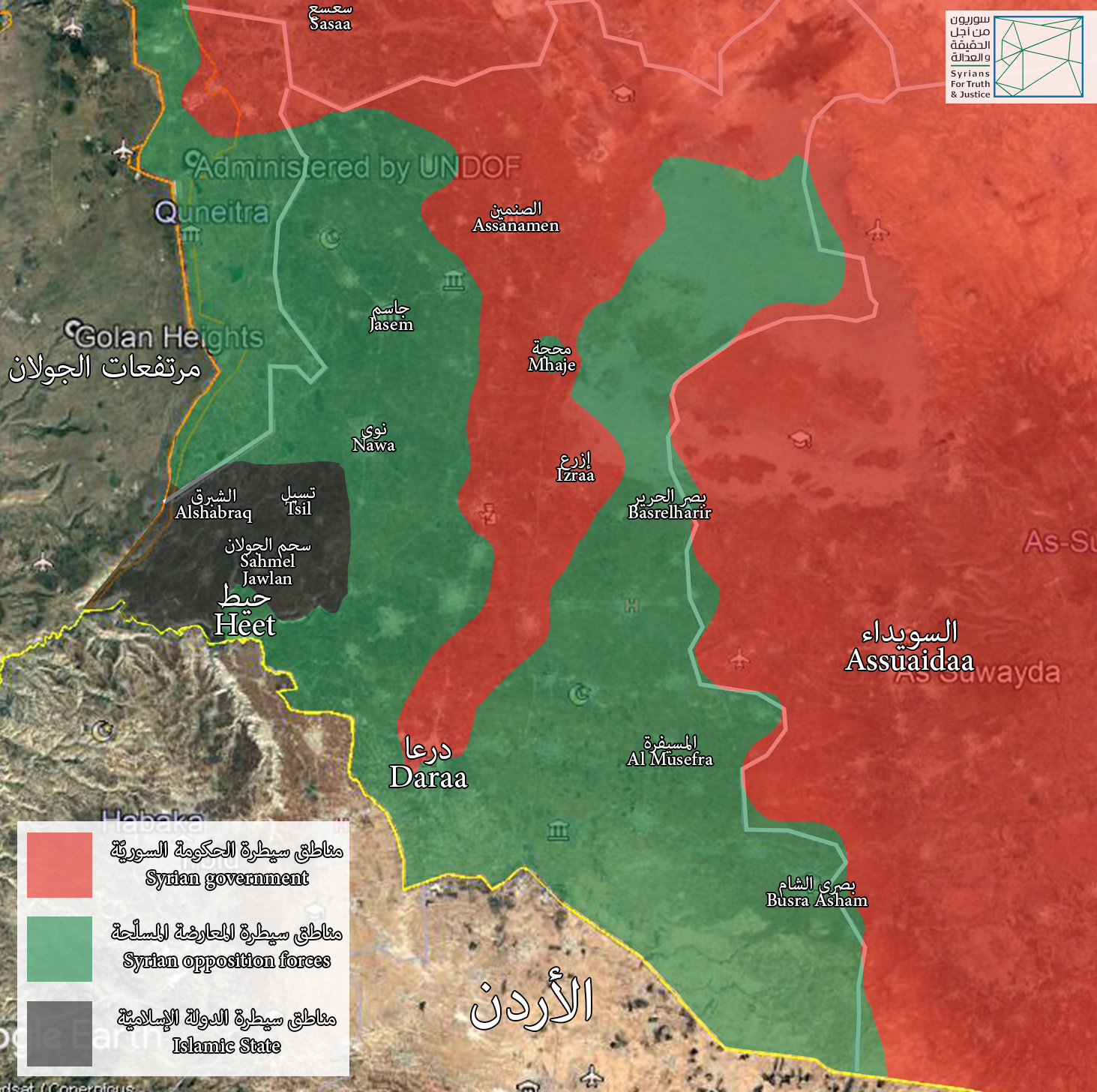
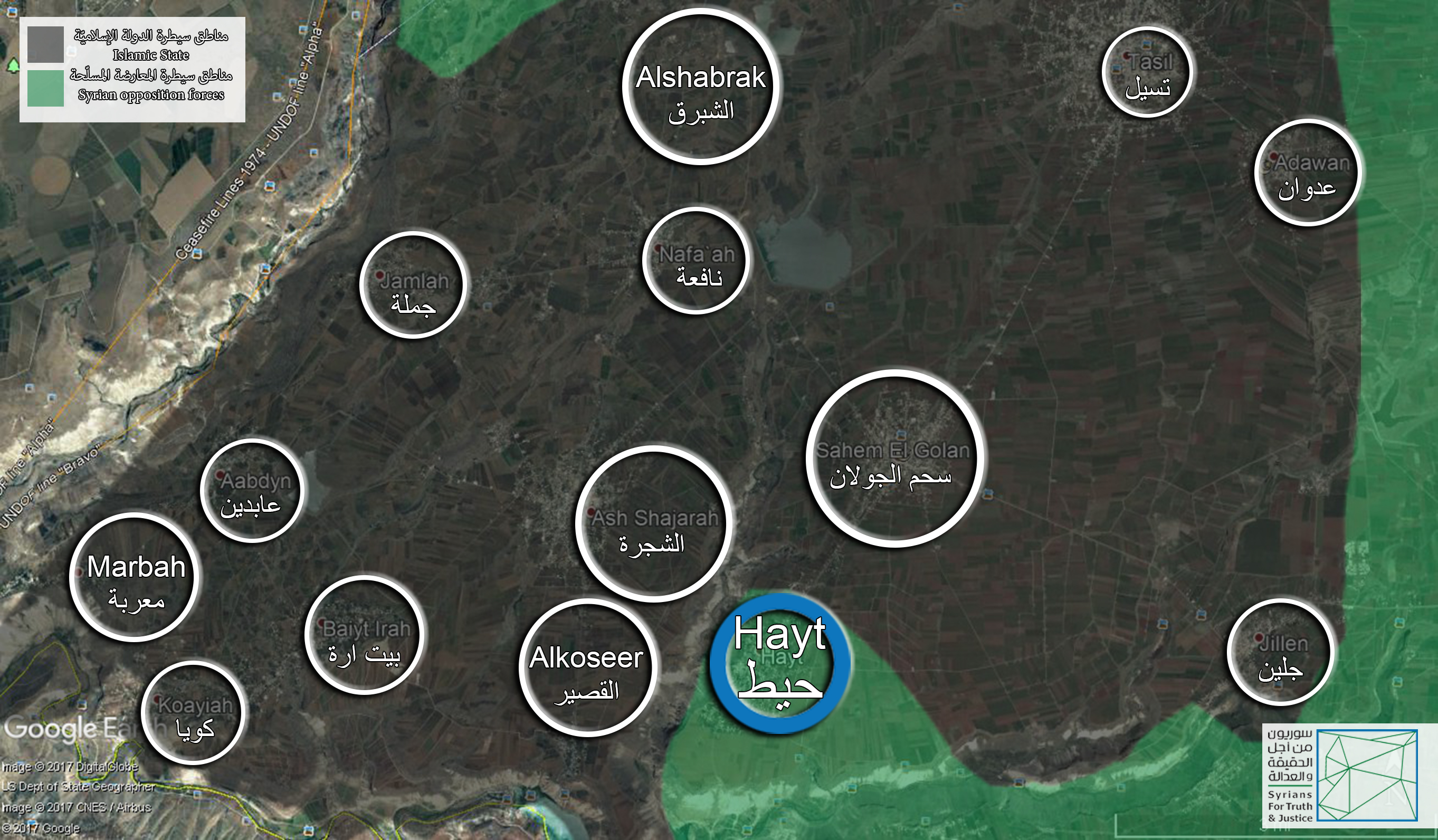
Satellite image showing the strategic location of al-Hayt town in the western Daraa countryside, where it mediates the towns of Hawd al-Yarmouk, and this might be the motivation of ISIS to attempt to break into it and control it several times during 2017 and in the previous years. This map shows the military forces-controlled positions until mid-September 2017.
First: The Outset of Offensive on Al-Hayt by Islamic State/ISIS/:
During the past months and years, al-Hayt town was subjected to several attacks by ISIS which used car bombs in most of those attacks, accompanied with indiscriminate shelling on the town. At the beginning of April 2015, al-Hayt was subjected to the first attack by ISIS to extend its control over the entire area of Hawd al-Yarmouk thus capture the entire western area of Daraa province. Meanwhile ISIS, represented by Yarmouk Martyrs Brigade[4], took towns like al-Shajara, Jmla, AinThaker, Nafa as a staging post, as the brigade had announced his pledge of allegiance to ISIS in April 2015, but in undeclared way. However, Hayat Tahrir al-Sham-HTS along with al-Nusra Front faced the Brigade’s expansion, but the other Southern Front factions of the Syrian armed opposition justified not to participate given Yarmouk Martyrs Brigade had not declared the pledge of allegiance to the Islamic State/ISIS/.
At the beginning of November 2015, Yarmouk Martyrs Brigade again launched a new military campaign in an attempt to control the villages and towns of Hawd al-Yarmouk including al-Hayt, but some Southern Front factions[5] of the Syrian armed opposition could repel the attack and pushed the Brigade to its bases.
Early March 2016, al-Hayt town was subjected to the third attack, as Yarmouk Martyrs Brigade along with Islamic Mouthana Movement[6] began a new military campaign intending to expand their control over villages and towns in western Daraa country side, but this campaign was violently repelled by Southern Front factions affiliated to the Syrian armed group. In addition to Ahrar al-Sham al-Islamiyya and al-Nusra Front could launch a counter-offensive and control the villages that the Islamic Mouthana Movement was stationed in, after besieging them in those villages.
On June 19, 2016, Islamic Mouthana Movement and Yarmouk Martyrs Brigade declared merging under the name of Jaysh Khaled Ibn al-Walid, it was an official declaration by ISIS.
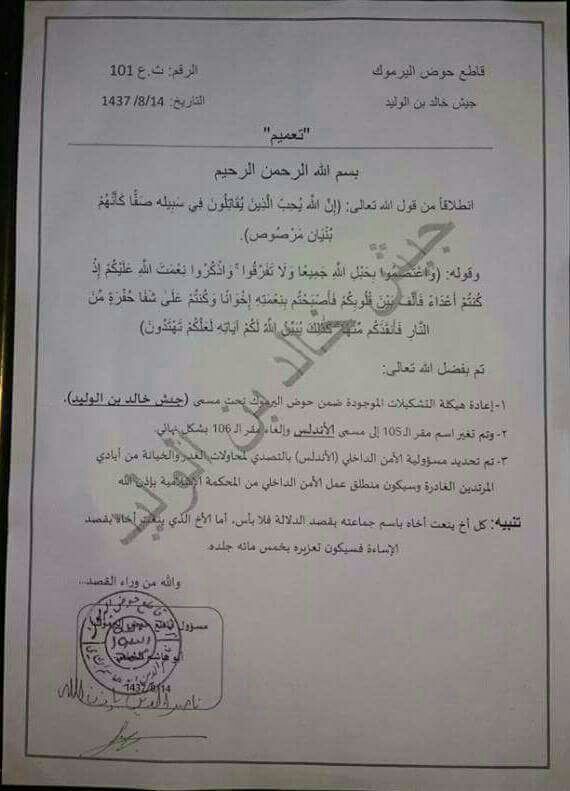
Image shows the circulation that announced merging between Yarmouk Martyrs Brigade and Islamic Mouthana Movement in the name of Jaysh Khalid Ibn al-Walid in Hawd al-Yarmouk area; on June 19, 2016, it was considered the official declaration to pledge the allegiance to ISIS.
Photo Credit: Local activists.
Mid-February 2017, ISIS, represented by Jaysh Khaled Ibn al-Walid, took advantage of preoccupation of Southern Front factions in fighting Syrian regular forces, and launched a military campaign to capture Tsel town during the battle "Death rather than Humiliation[7]" along with Sahem, aL-Golan and Glenn, as well as the strategic towns of al-Jomou hill and Tal Ashtaraa.[8] The Organization continued advancing towards al-Hayt, but the town's factions repelled the attack and prevented ISIS from breaking into it. Anyway, the geography of the town and ISIS controlling the surrounding villages led to impose a siege on al-Hayt, on 19 February 2017, from all sides, except the southern side, which is towards the Yarmouk Valley, because this way is known for its ruggedness and danger, and because part of it is subject to sniping by ISIS agents.
Al-Hayt town resisted the suffocating siege imposed on it, and many of its factions agreed to form a military junta to protect the town, therefore, deployed advanced ambushes to transfer the battles out of town, in case ISIS tried to advance towards them. However, on Sunday morning, June 25, 2017, ISIS managed to breach one of the ambushes and got into the town, where fierce battles took place between ISIS and the military factions stationed in the town. ISIS was defeated and most of its troops that could enter the town were killed. As a result, ISIS imposed its siege on al-Hayt, which is still ongoing until the date of the present report in mid-September 2017.
Second: Civilian Casualties and Injuries in the Indiscriminate Shelling on Al-Hayt
Parallel to ISIS attempts in controlling al-Hayt whether during 2017 or during the previous years, ISIS was shelling the town indiscriminately, killing and injuring dozens of civilians, mostly women and children. In addition to scores of cases of settling scores and summary executions of local civilians from al-Hayt by ISIS for various reasons, according to STJ reporter.
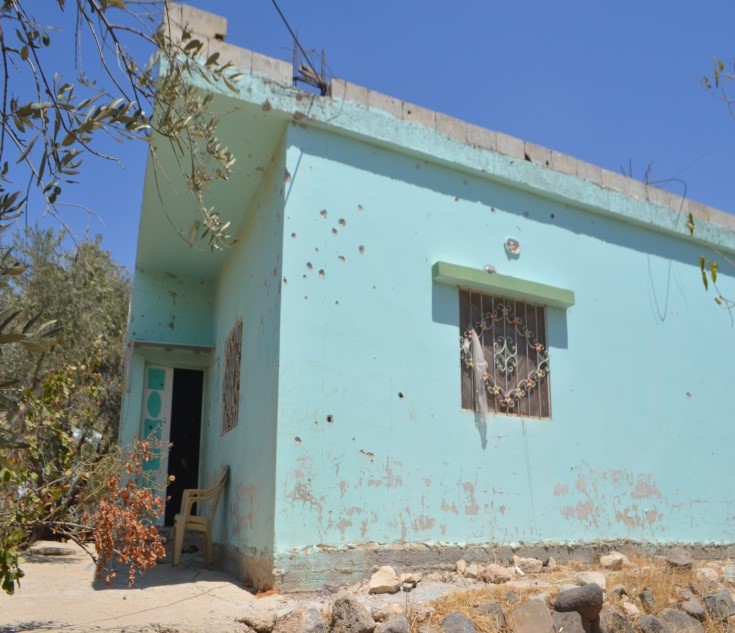
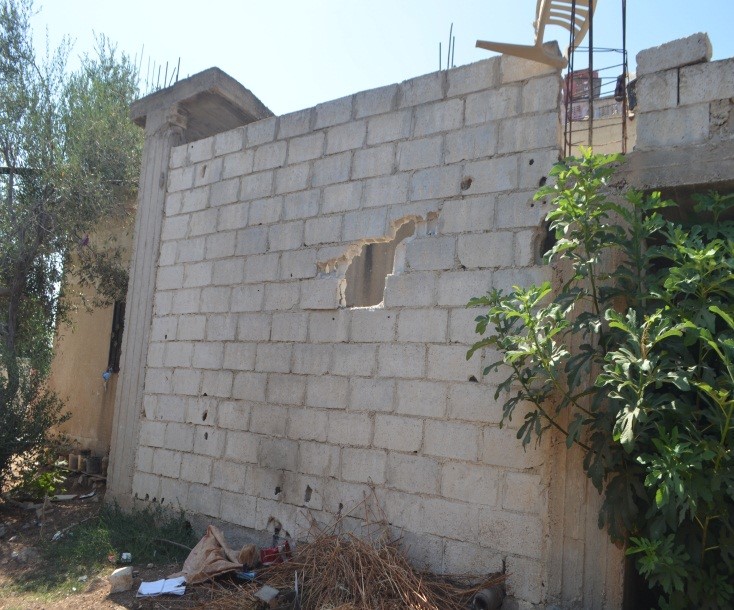
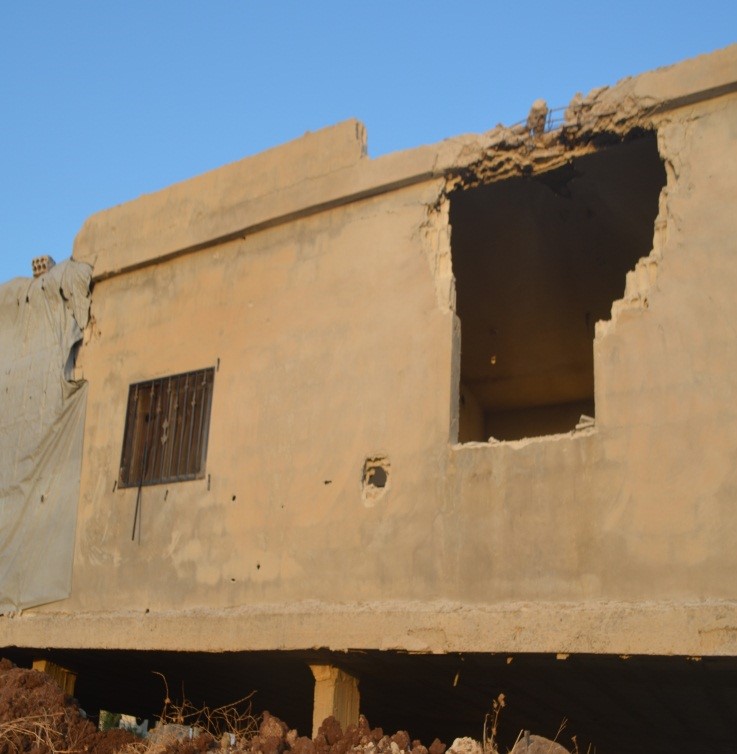
Images show some of the damage caused by the indiscriminate shelling on al-Hayt during the previous months of 2017. Taken in August, 16, 2017.
Photo Credit:STJ
Ali Mohammed al-Jaldaa, hails from al-Hayt town, died on June 25, 2017, due to a stroke as a result of the fear of the indiscriminate shelling of his hometown by ISIS on the same day.
On Monday, February 20, 2017, the child, Ahmad Mustafa Badawa, was killed as a result of the indiscriminate shelling on the town by ISIS. Ahmad was affected with one of the fragments that pierced his head and was transferred to the kingdom of Jordan for cure, but he died there on March 11, 2017.
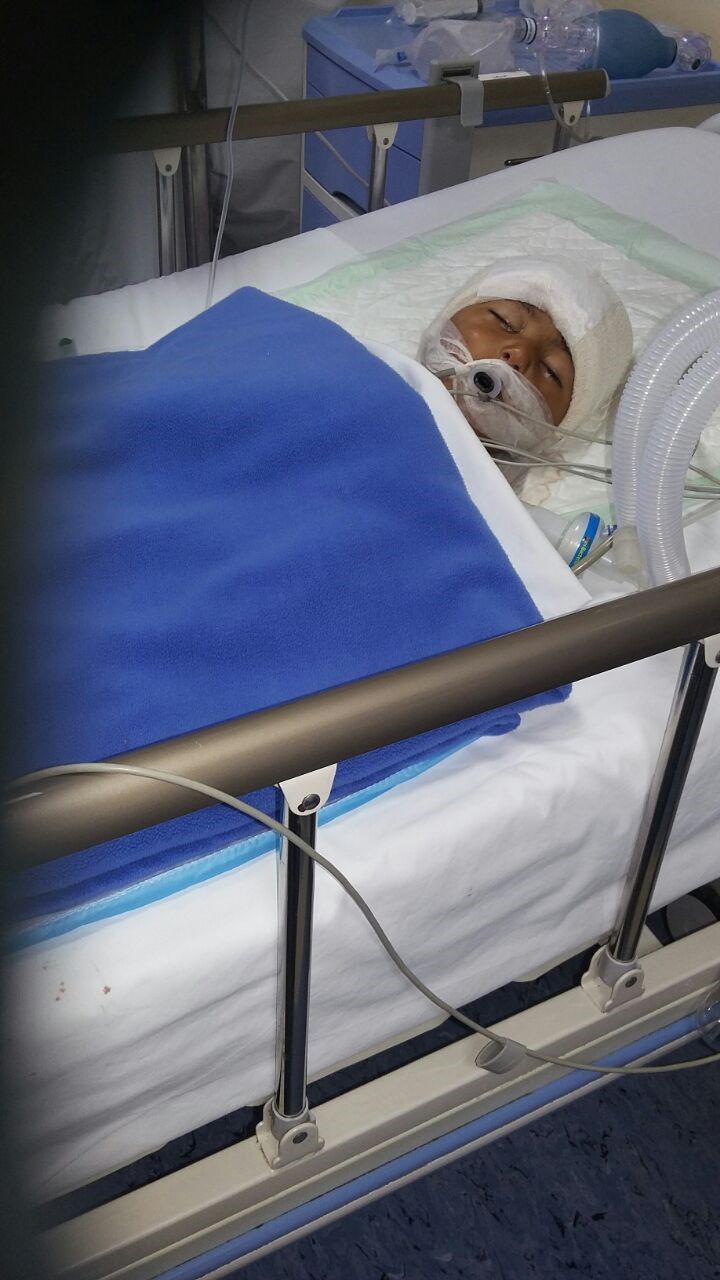
Image shows the child, Ahmad Mustafa Badawa, shortly prior his death as a result of the indiscriminate shelling on al-Hayt February 20, 2017. Ahmad was being treated in the Kingdom of Jordan on February 21, 2017.
On Sunday, February 19, 2017, a young man identified as Yusuf Musa Badawa was summarily executed during the entry of ISIS troops into al-Hayt. In this regard, Um al-Abed, Yusuf’s relative, spoke to STJ:
“Following the execution of my cousin Yusuf and shooting him by elements of ISIS, my husband, Yaser, rushed to rescue him out of town, but we didn’t hear about them for three days, then, we knew later that they were killed on a checkpoint run by ISIS in Glenn.”
In a related context, Bandar Musa al-Ta’ani, a woman from the town, said that she had lost two of her sons on the same above mentioned checkpoint, coinciding with indiscriminate shelling on the town Sunday, February 19, 2017. Concerning the incident, she talked to STJ:
“On that day, the town was targeted by several mortar shells, one of them fell near our house, and my son identified as Nabil Terki al-Aqraa and his wife Baraa al-Nasiri were wounded. Immediately, my other son identified as Samir Terki al-Aqraa, dispatched them outside the town, and news of them cut for two continuous days. Later, I learned that the vehicle transferred them was burnt near a checkpoint run by ISIS in Glenn, subsequently, certain people confirmed to me that ISIS agents heavily shoot their vehicle causing it to burn along with every one inside it.”
To see the whole interview with the witness “Bandar Musa al-Ta’ani”, please click here.
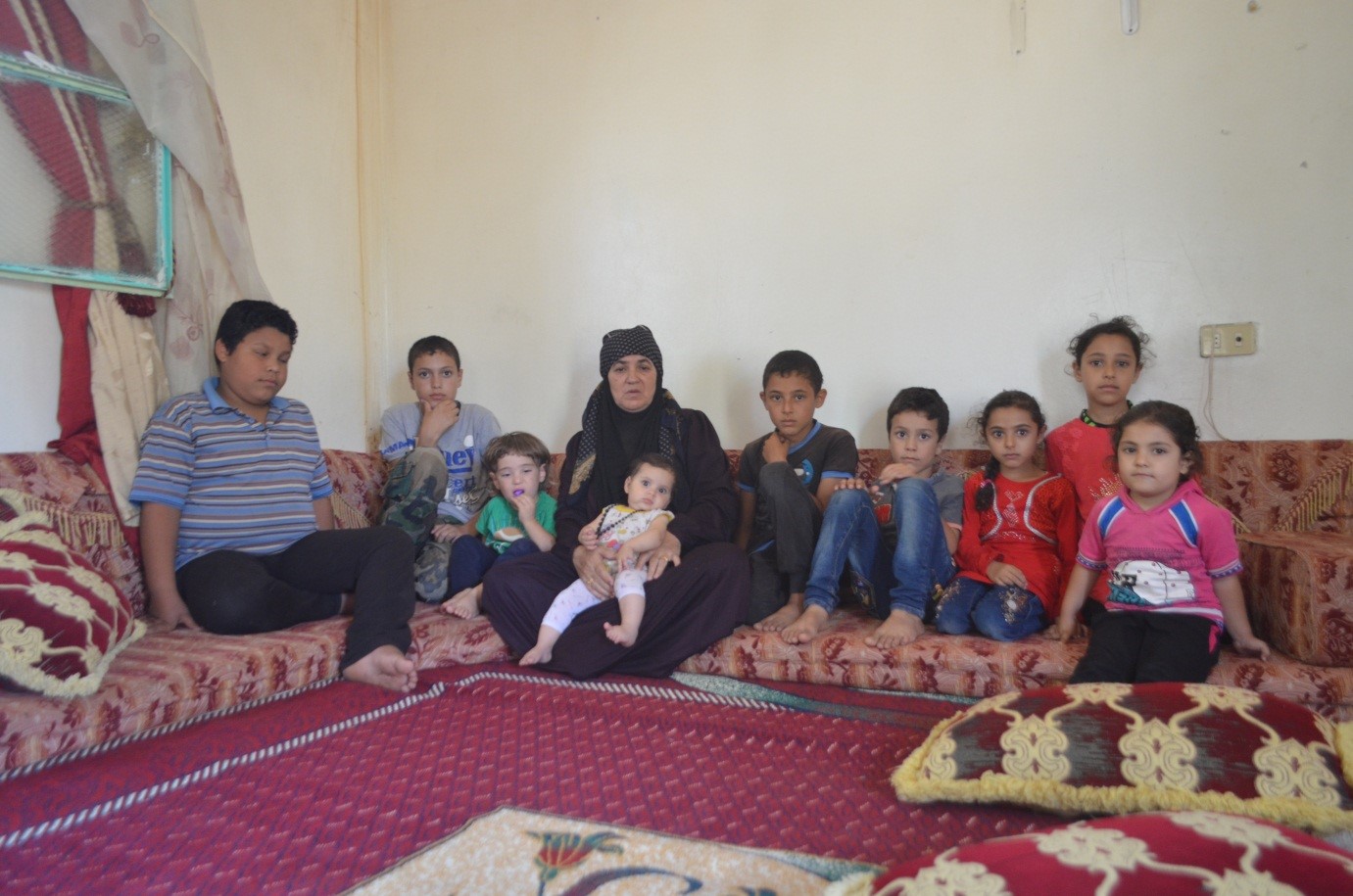
Image of kids of the two victims, Samir and Nabil al-Aqraa, who were killed by ISIS, on 19 February 2017.
Photo Credit: STJ
On Sunday, 27, December 2015, the child Mohammed Nae’em al-Aqraa, was killed after being shot in the head while he was leaving his school, and according to the testimony of Nae’em al-Aqraa, his father, it was found out later that it was a machine gun shot that came from ISIS-held al-Qaseer town adjacent al-Hayt from the western side.
To see the entire interview of the child’s father please click here.
In addition to scores of people who were killed as a result of indiscriminate shelling on al-Hayt by ISIS, during 2017 or even prior years, dozens of civilians from the town were seriously injured as well, such as Ibtisam Kheder al-Mesri who was injured on Thursday evening, June 15, 2017, as a result of shelling the town.
On September 19, 2016, Nidal Ahmad al-Ayshat was seriously wounded and became paraplegic following the indiscriminate shelling on the town, he said in his testimony to STJ:
“On the morning of that day, I was teaching at a school in the town when the organization targeted the western side of the town with several rounds of anti-aircraft. I was shocked when one of the shots passed through my body, and given the seriousness of my injury, I had to be taken to neighboring countries, but the Jordanian border was blocked, so, I was dispatched to Israel where I received the treatment, but the injury lastly caused me paraplegic.”
The 10-years-old child, Abdelhadi Moushir al-Gazawi, was hit on his foot, caused him to lose it, during shelling al-Hayt by ISIS on May 7, 2015.
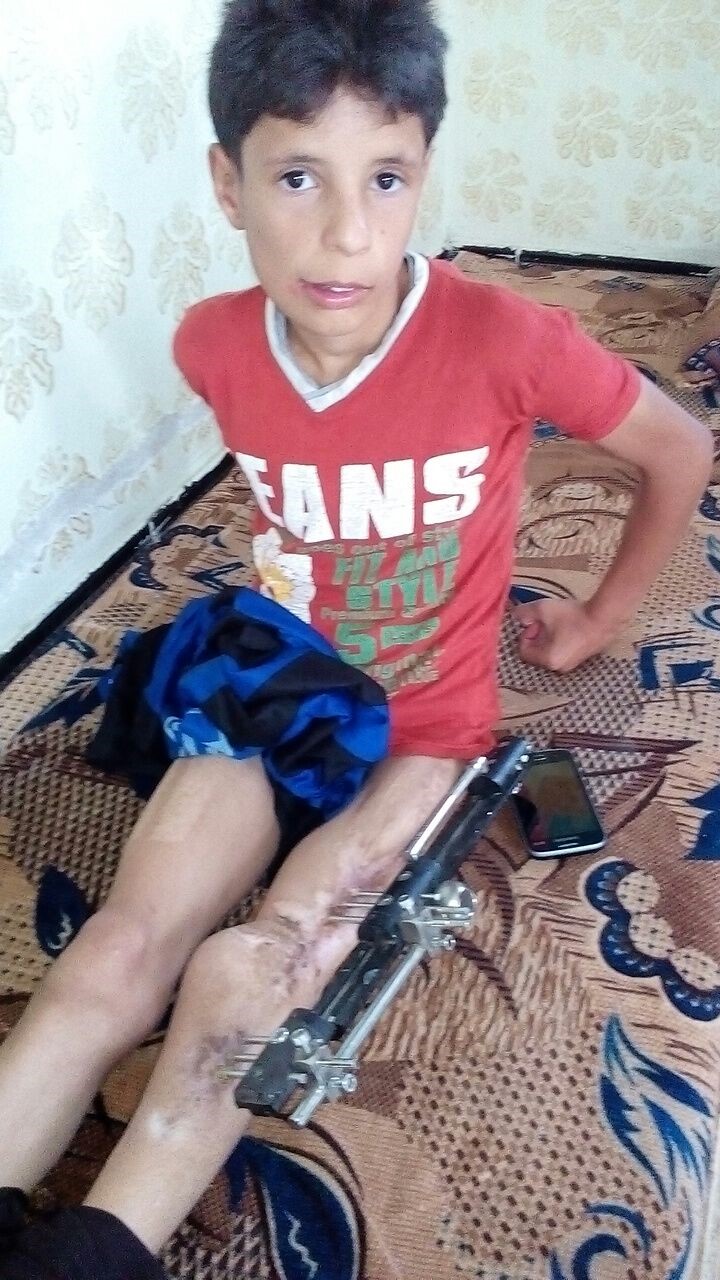
Image shows the injury inflicted on the child, Abdelhadi al-Gazawi, as the result of shelling al-Hayt on May 7, 2015.
Photo Credit: STJ
Third: Suffering of Al-Hayt People under Siege
On 19 February 2017, Islamic State/ISIS/ imposed a siege on al-Hayt affecting negatively on all aspects of life in the town. The electricity network was damaged because ISIS destroyed the power transformers, and the town suffered from severe water shortage as well, the matter that Tariq Tawfiq al-Janini, the Head of the local council, confirmed to STJ:
“Al-Hayt town is poor with groundwater and depend in its drinking water on wells in Sahem al-Golan, but after ISIS controlled the town, they cut off water, so we installed pipes to pull water from the Yarmouk Valley and then distribute it to locals, but this water is often contaminated due to their overlapping with waste water pipes. Hence, some diseases showed up among people such as typhoid. Concerning the humanitarian assistance, they are very scarce, and sometimes almost absent, except for the Assistance Coordination Unit /ACU/, the only party that still provides us with flour.”
Mohammed al-Kanawi, a resident of al-Hayt, assured STJ that living within the town was very expensive because of the siege imposed on them, noting that the family breadwinner needs daily SYP 2000 in order to provide his family needs, he continued:
“In general, the cost of entering goods into the city is very high, which led to inflated prices of all food items, estimated at 25% compared to prices in other liberated areas, but we lack job opportunities as a result of the chocking siege. Anyway, our town was considered an agricultural one and the majority of its population worked in the farms, the blockade led to the cessation of such works."
To see the complete interview with the witness "Mohammed al-Kanawi", please click here: video no.1 – video no.2 – video no.3
Concerning the medical care, al-Hayt town lacks specialist doctors and there is only one medical center established by a local nursing staff with personal efforts, and in this regard, Adnan al-Safouri, the director of the medical center, spoke about the type of the diseases spread under the siege, particularly because of contaminated drinking water, he said:
“We receive about 75 patients a day, and we have recently observed the spread of typhoid as a result of contaminated drinking water. Besides, in checking some children, we noticed the spread of malnutrition, but the most we suffer from is the lack of specialist doctors, in addition to a great shortage in medical supplies and medication needed for serious cases; there are some hospitals in the area that provide us with very small amounts of medication, but they are insufficient.”
A video footage published on August 30, 2017, by the Yaqeen News Agency showed the difficulties that the medical staff face in the besieged al-Hayt by ISIS for more than six months ago.
At the educational level, ISIS attacks on al-Hayt denied many students of education, particularly in the years 2016 and 2017; this caused prevalence of illiteracy among the children whom aged 10 years old at the minimum, as well as the orientation of a large segment of them towards acts of violence and mobilization. This was confirmed by Bahaa al-Kanawi, the director of Baraem Center for Psychological Support in the town, he said:
“We have established the center to improve the student’s behavior and to maintain the safety of children's thought against extremism and apostasy, especially with the emergence of ISIS organization in the region. We have also worked to create an awareness program for children from the remnants of war and unexploded ammunition, but lack of the support provided to the center, and the state of instability and terror in the town because of ISIS, disabled us from working.”
the economic losses affected al-Hayt due to the siege imposed by ISIS are estimated by hundreds of millions, given more than 50% of the capitals of the townspeople were invested in agriculture but ISIS Organization captured many lands on the outskirts of the town, and burnt many agricultural crops in May 2017. In this regard, Abu Qasim, hails from al-Hayt, spoke to STJ, he said:
“Many of our agricultural crops damaged because of the siege, our region used to carry a burden of 40% of market consumption in Horan city, but this year the harvest season coincided with the siege imposed on the town causing a great losses to us. Some people estimated their losses at about 65%, while others at 100%, all that due to extra costs and the difficulty of transporting crops under the siege.”
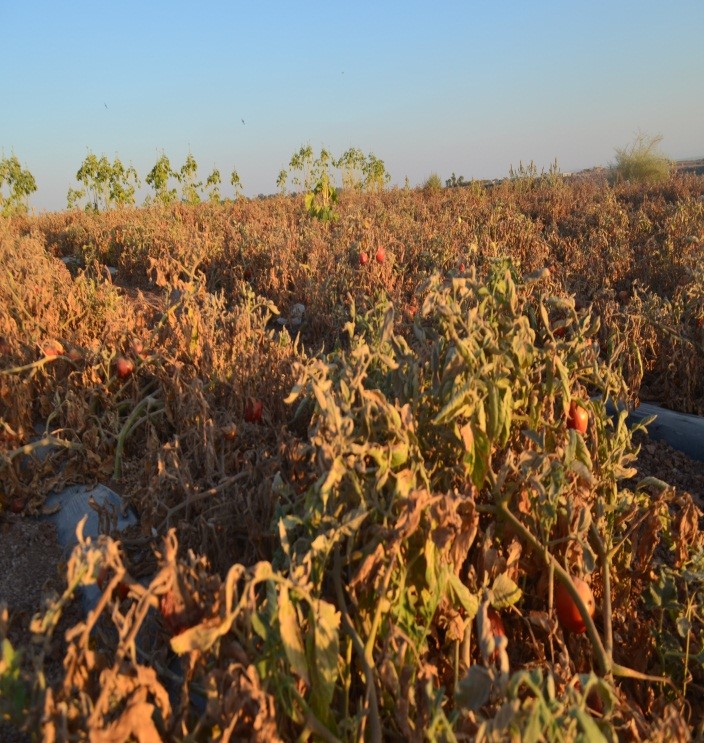
Image shows some damaged crops due to the siege on al-Hayt for more than six months ago by ISIS. Taken August 18, 2017.
Photo Credit: STJ
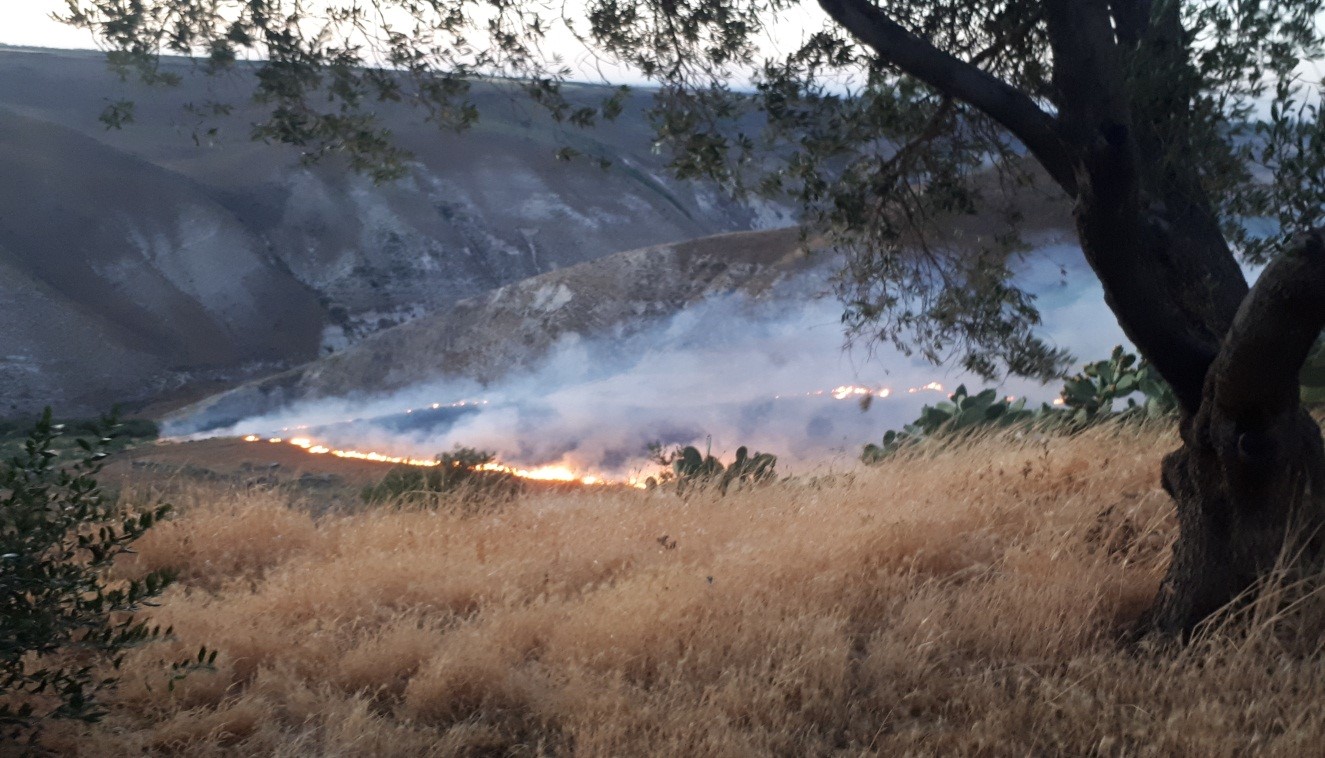
Image shows some agricultural crops burnt by ISIS in the besieged al-Hayt town, in May 2017.
Photo Credit: Alaa al-Mesri, an activist from the town.
[1] The army was formed after the merger of several factions fighting against the Syrian regime, including Islamic Mouthana Movement and Yarmouk Martyrs Brigade; the merger was announced in June 2016. There are approximately 800 fighters, and are currently deployed in many towns in Daraa countryside, namely, al-Shajara, Jmla, AinThaker, Qaser, Adwan, Tsel, Nafa, Sahem El Golan, Glenn, Muzeraa, Shabraq, Bayt Ara, Kuwayah, and Maariyah.
[2] The military Junta consists of: Ahrar al-Sham al-Islamiyya and al-Haqq Division affiliated to the Southern Front Brigade, which in turn includes a number of other factions, they are Al-Harameen Brigade, the Sabreen Brigade, the 99 Infantry Brigade, Liwaa Borouj al-Islam, Special tasks/Al-Mahham Al-Khasa Brigade, the Al-Karama brigades, Al-Hara Martyrs Brigade, Martyr Raed Al-Mesri Brigade, the Knights Brigade of the 46 Infantry Division and the descendants al-Walid of the coalition of the Revolutionary Army/Jaysh al-Thawrah.
[3]In February 2017 The towns of Tsel, Sahem El-Golan, Glenn were captured, whereas the other areas, such as, al-Shajara, Qaser, Nafa, Kuwayah, Abdeen, and Ain Thaker , were mainly held by Yarmouk Martyrs Brigade that originated at the end of 2012 in Hawd al-Yarmouk area under the name of a Yarmouk Martyrs Brigade, which exist only in the western part of Daraa and later pledged allegiance to ISIS organization. Activists told STJ that the Brigade was supported by the Military Operation Center /MOC/ for the coordination of military operations in Jordan and was partially cut of support in 2014 and then fully following the kidnapping of United Nations elements by the brigade in June 2013.
[4] A brigade formed in the western region of Daraa province late 2012, before pledging allegiance to ISIS, it used to call itself "Yarmouk Martyrs' Battalion", led by Muhammad Saad al-Din al Baredi, alias "al-Khal/Uncle"; the Brigade joined several battles against Syrian regular forces, and are deployed in several villages and towns of Hawd al-Yarmouk.
[5] Factions under the formation of the Southern Front fighting against ISIS in Hawd Yarmouk region are: Liwaa al-Harameen, Sabreen Brigade, the 99 Infantry Brigade, al-Islam Borouj, the Special Task Brigade/ al-Maham al-Khasa, Al-Karama Brigade, Al-Hara Martyrs Brigade, martyr Raed al-Mesri Brigade and the Brigade of the Knights 46 Infantry and the descendants Al-Walid of the coalition of the Revolutionary Army/Jaysh al-Thawara . At the beginning of 2014, most of the armed opposition factions in Daraa, Quneitra and some factions, up to twenty faction, in Damascus and its southern countryside declared the formation of the so-called Southern Front, which coordinates its military operations in cooperation with MOC Room" located in Jordan against the forces of the Syrian regime and ISIS.
[6] It was an Islamic movement, formed in mid-2012, under the name of "Mouthana Ben Harith", and later developed as Islamic Mouthana Movement, and was located in several villages in the western countryside of Daraa (Sheikh Saad, Glenn, the houses of Glen, and Maariyah) in addition to being in some neighborhoods of Daraa city, Tariq al- Sad and Daraa al-Ballad. The number of its fighters was estimated at 250, with approximately 100 troops split up after the merge with Yarmouk Martyrs Brigade and the formation of "Jaysh Khaled Ibn al-Walid", which was a member of the Islamic State Organization/ISIS/, on 19 June 2016.
[7] Started on February 11, 2017, after the Syrian regular forces attempted to advance towards the Ancient Customs of Daraa/Jomrok Daraa al-Qadem, which connects Syria with Jordan and is held by Syrian armed opposition control, the opposition factions repelled to this attack represented by the Headquarter room in al-Bunyan al-Marsous and launched a counter-offensive in which it could liberate about 90% of al-Manshiya that was held by the regular forces after a battle lasted nearly four months.
[8] They are characterized by geographical location that overlook several towns in Hawd al-Yarmouk, such as Sheikh Saad, Al-Tireh and Glenn and Tsel.

